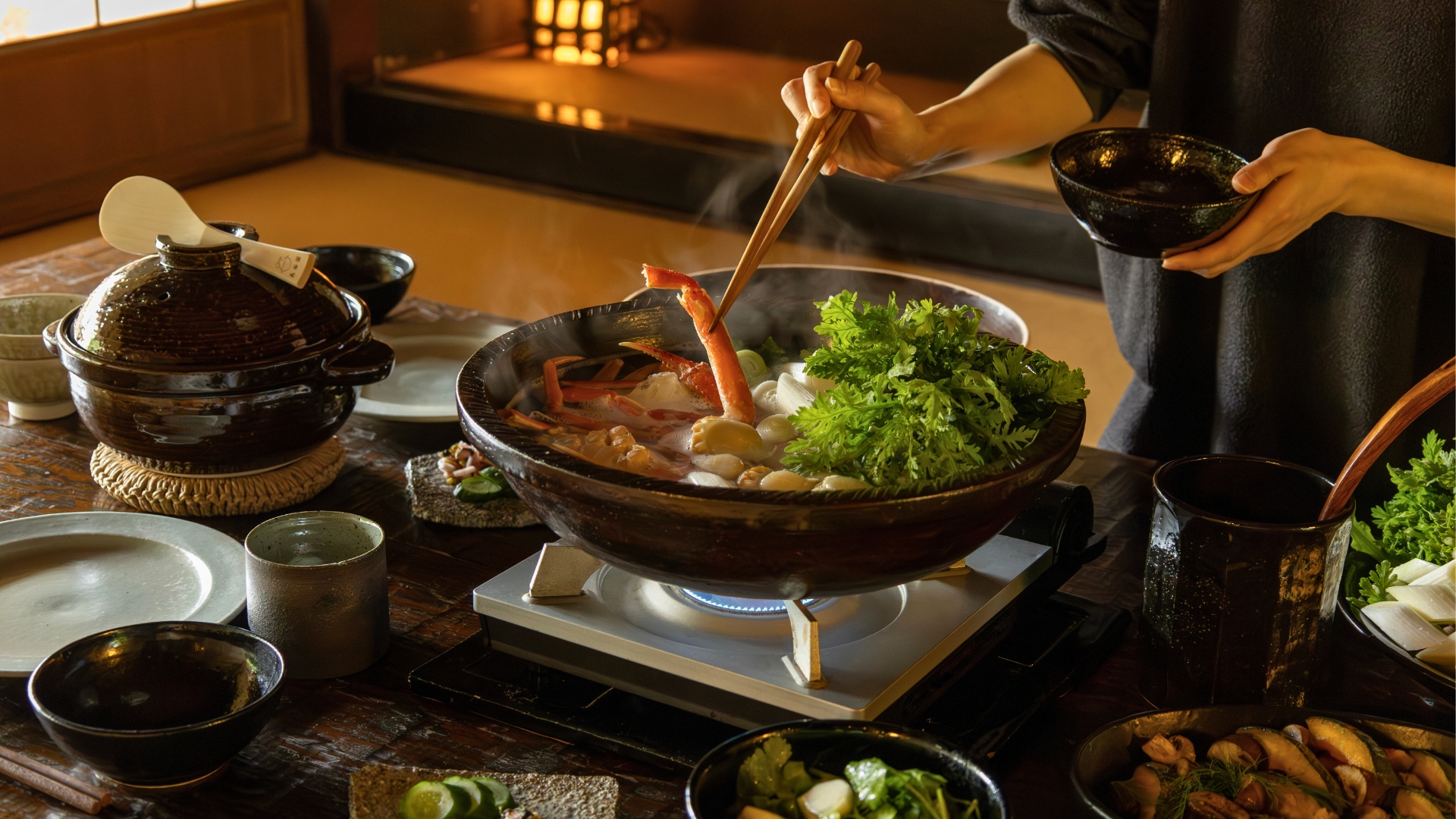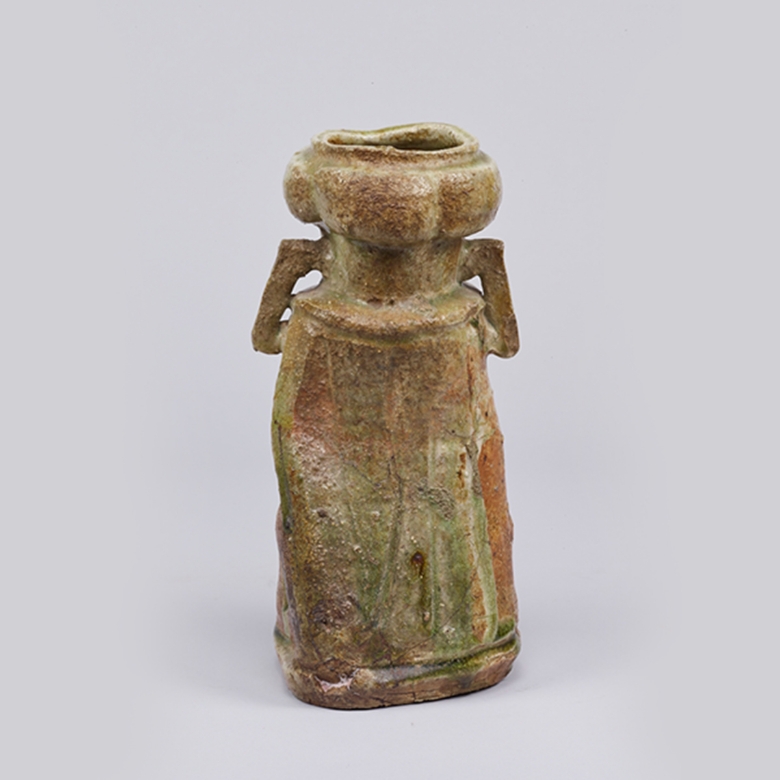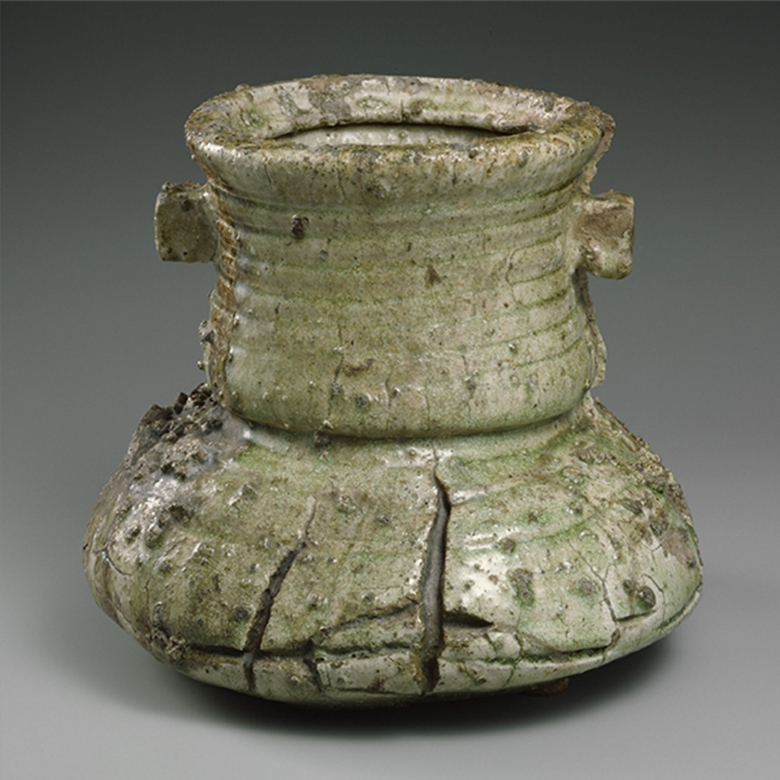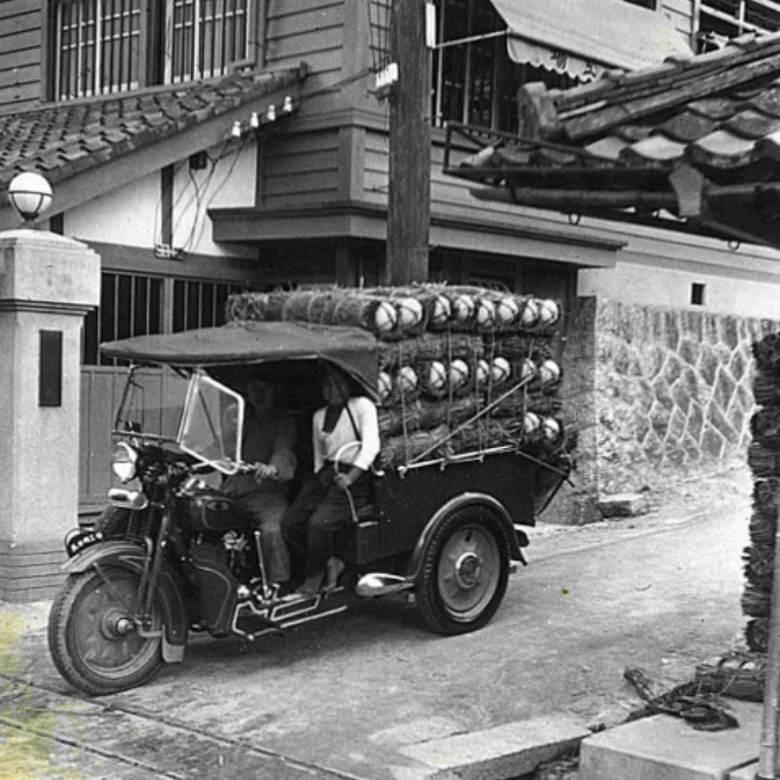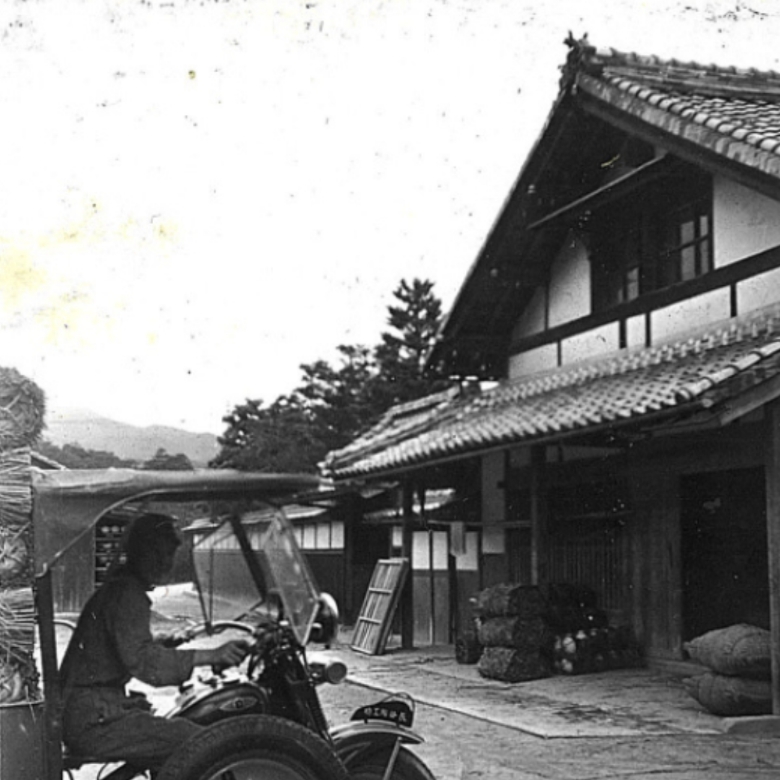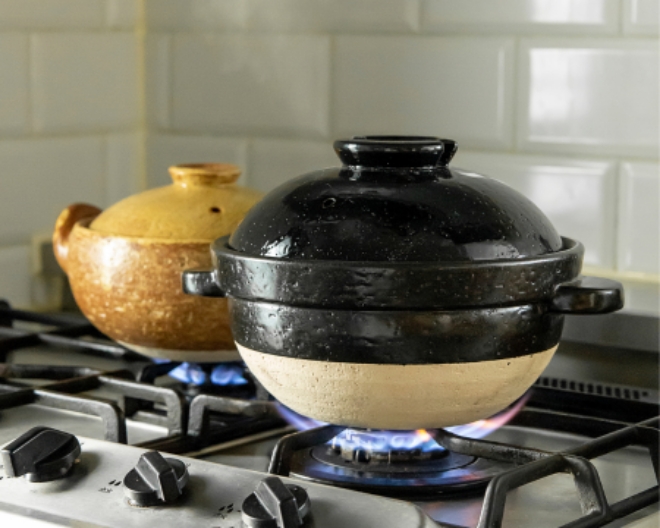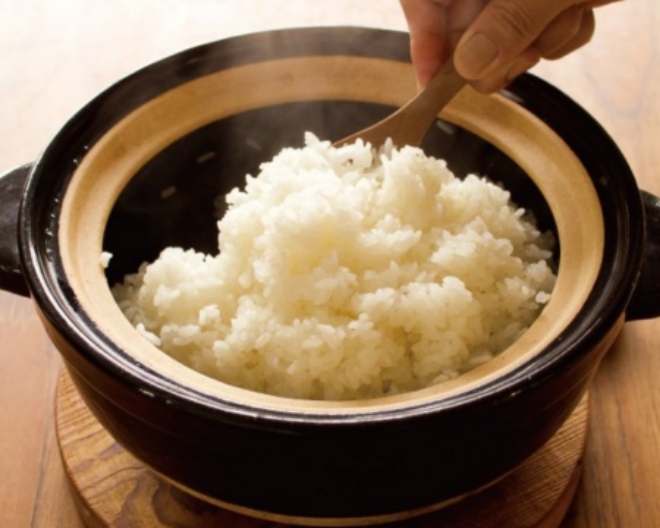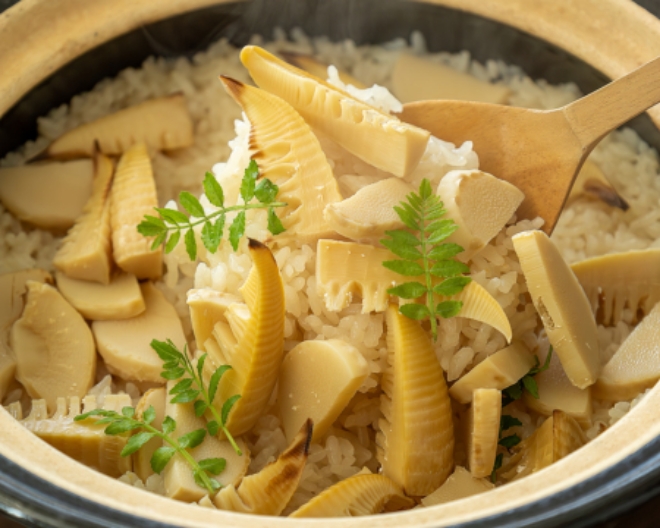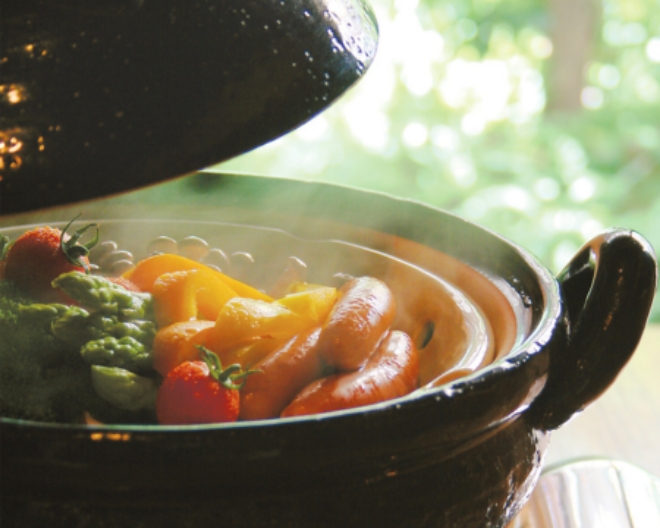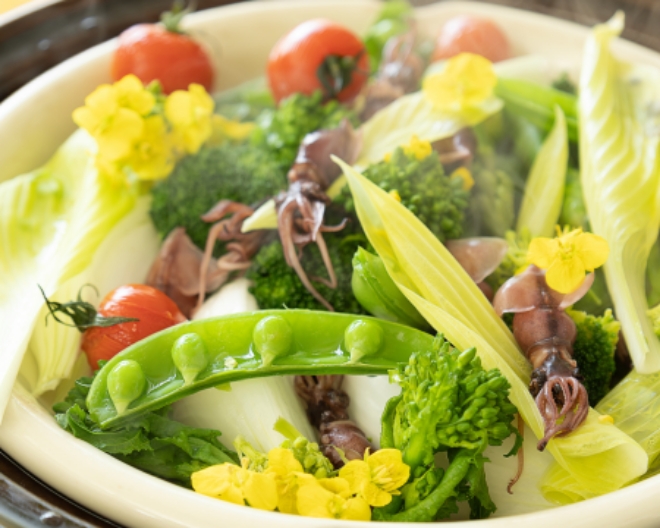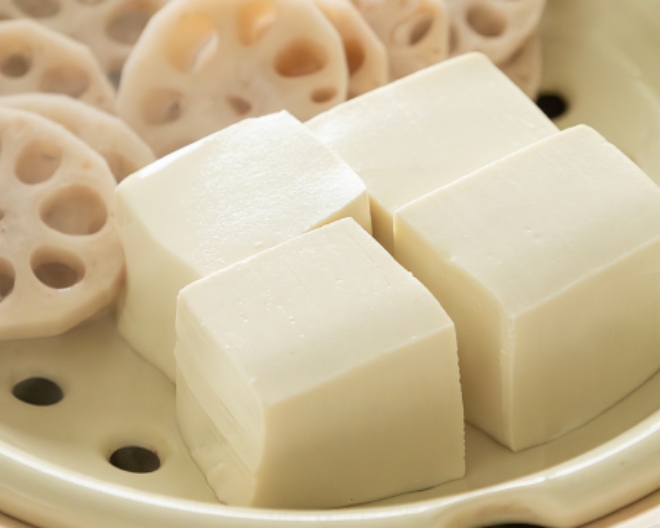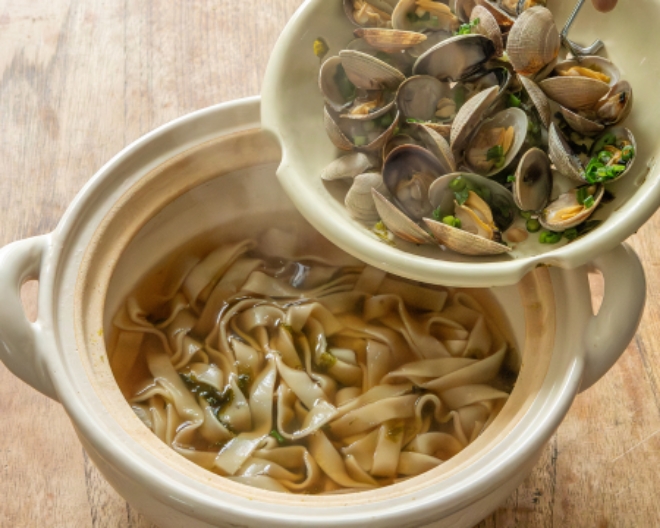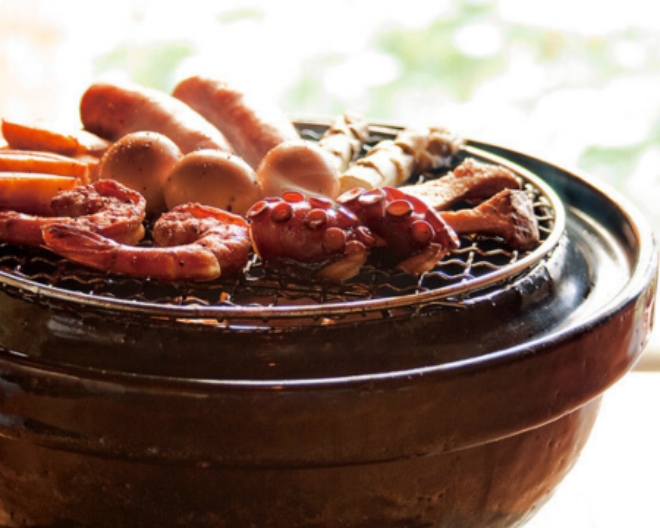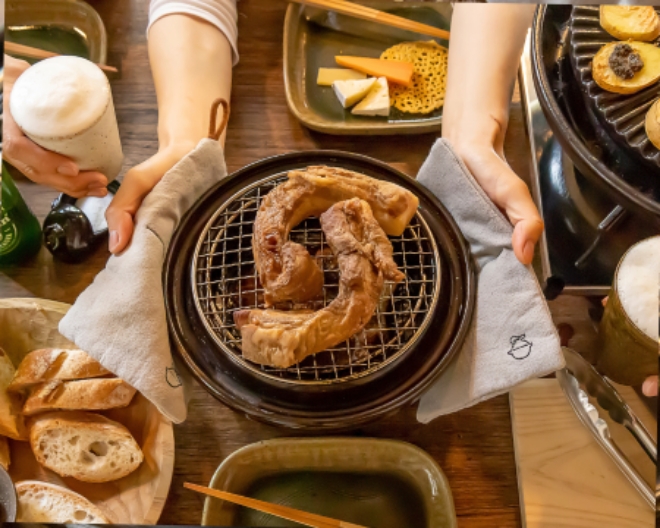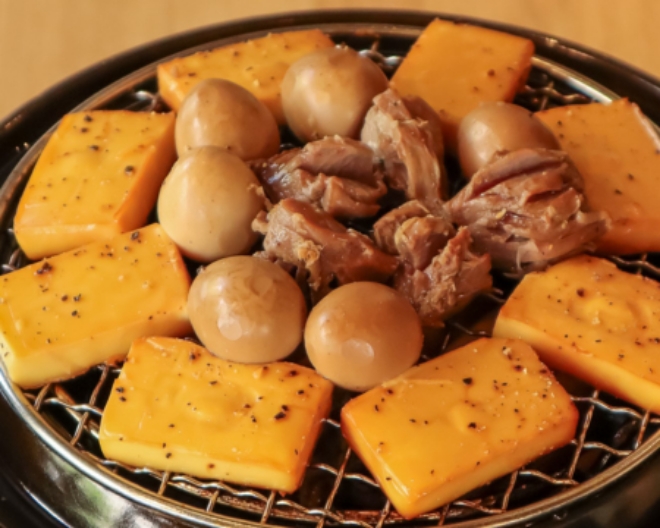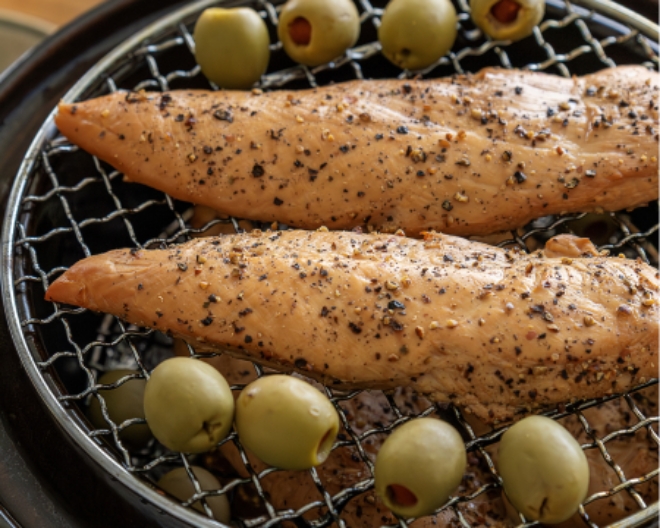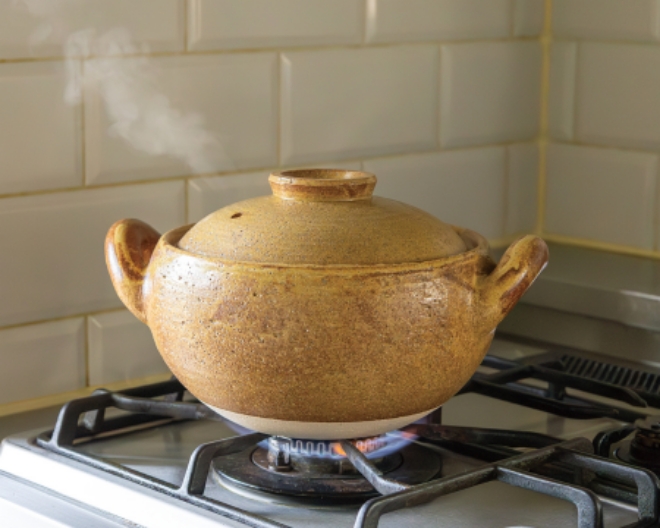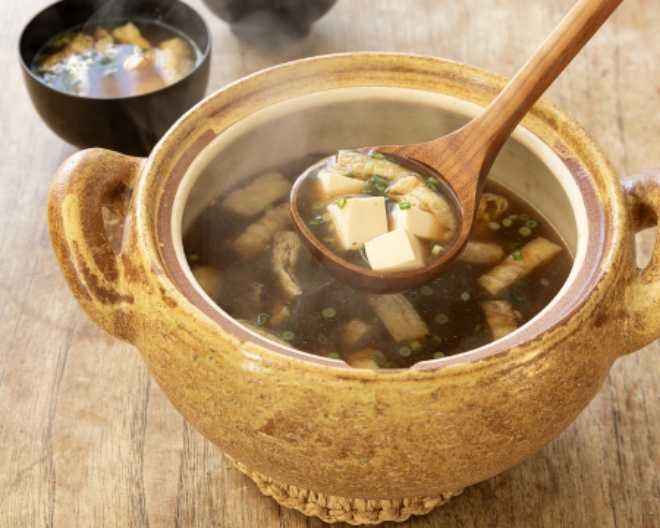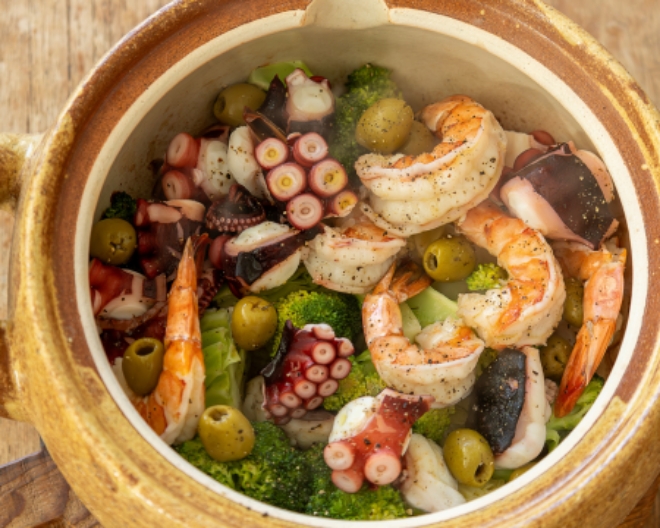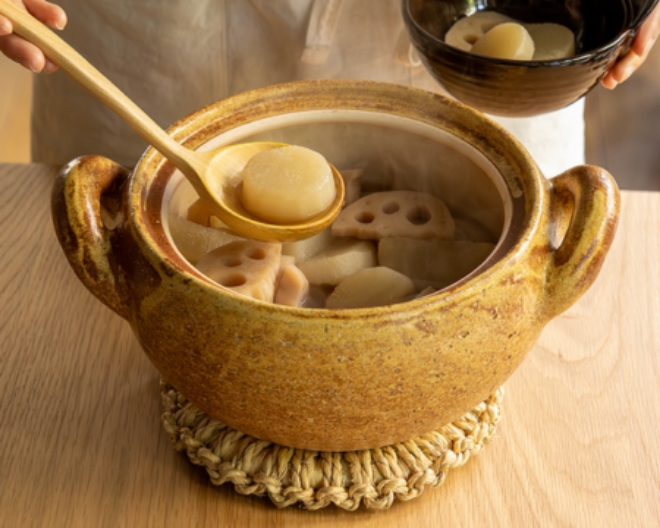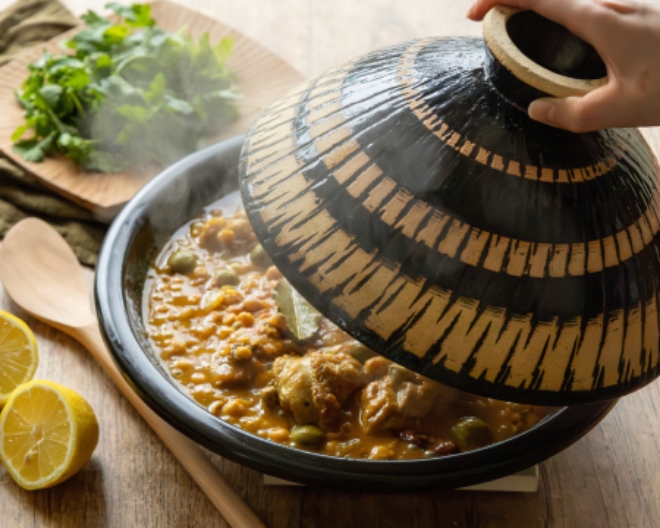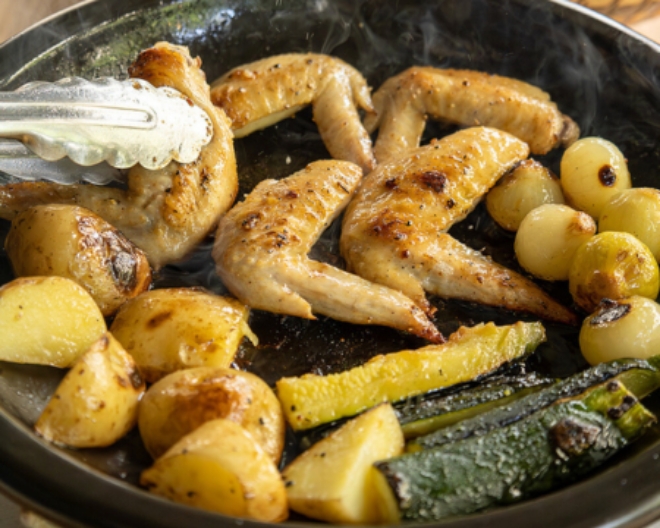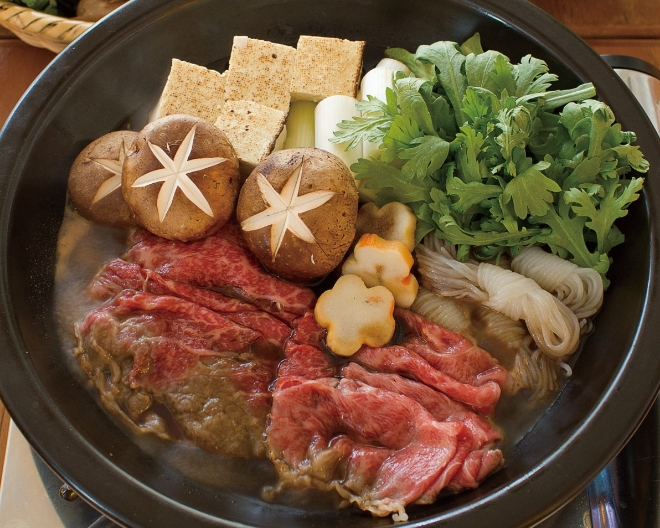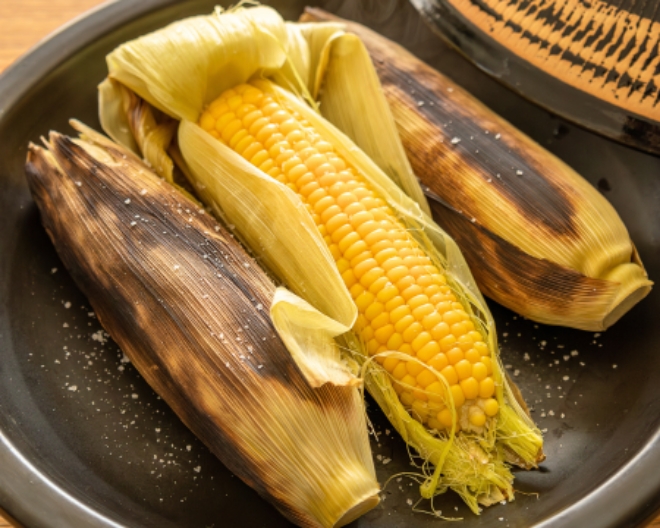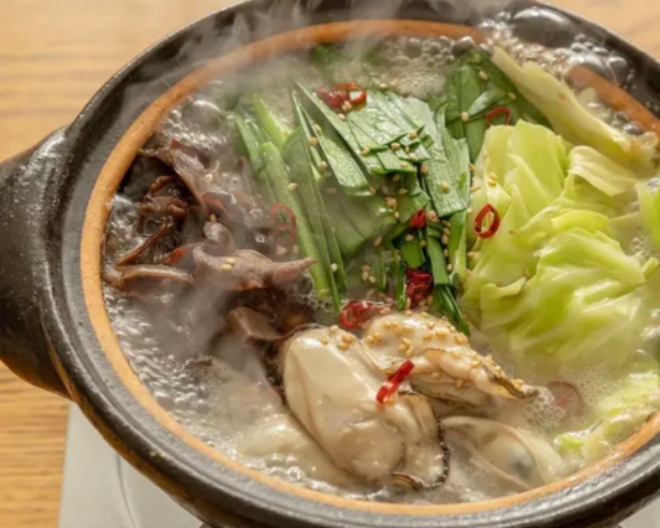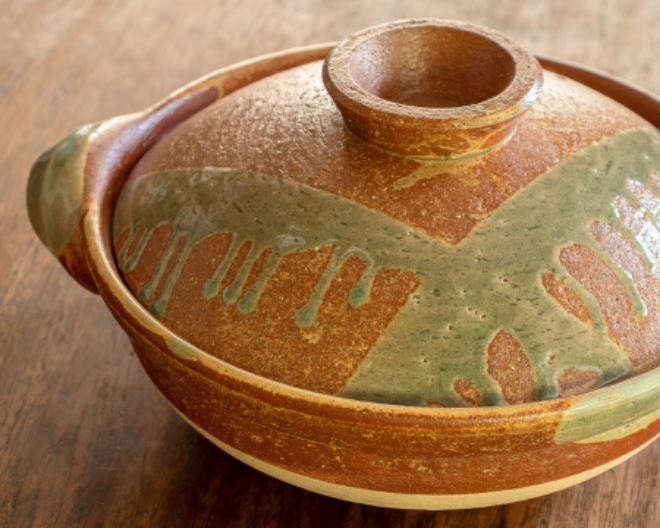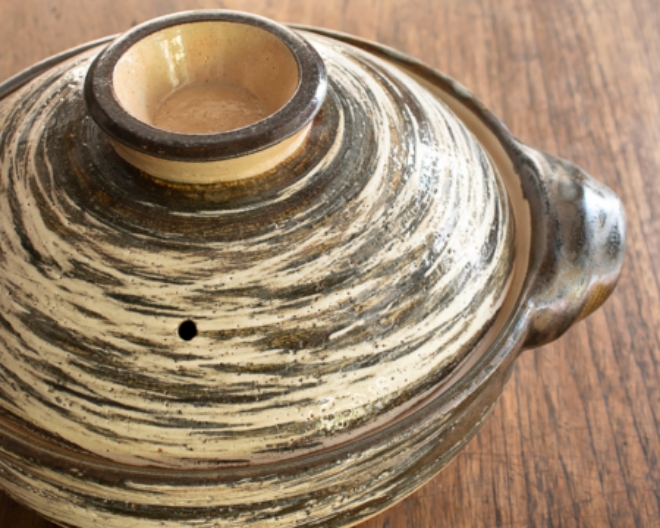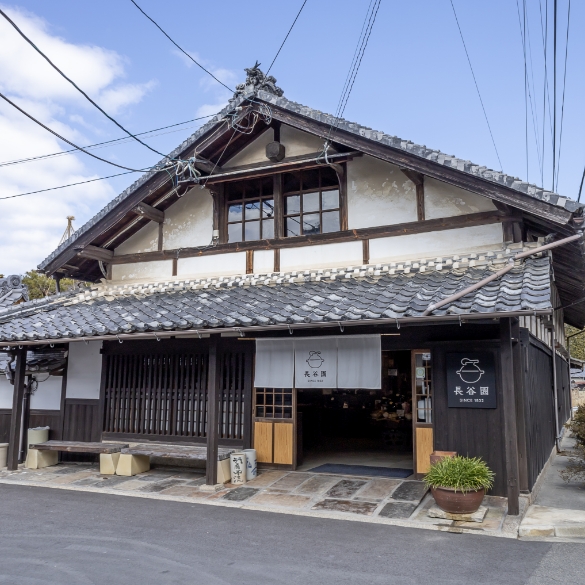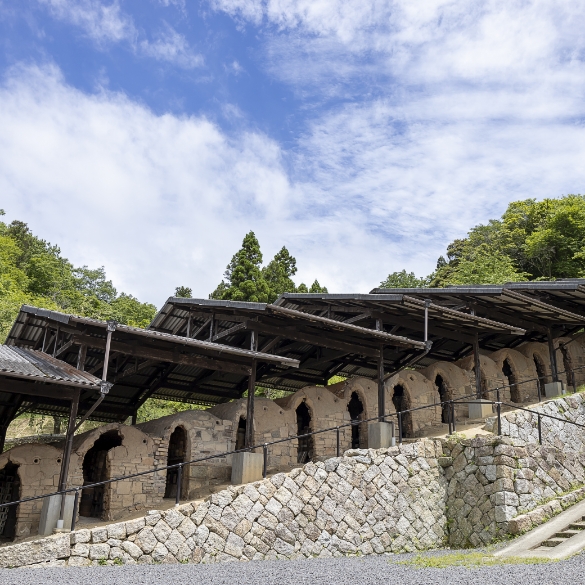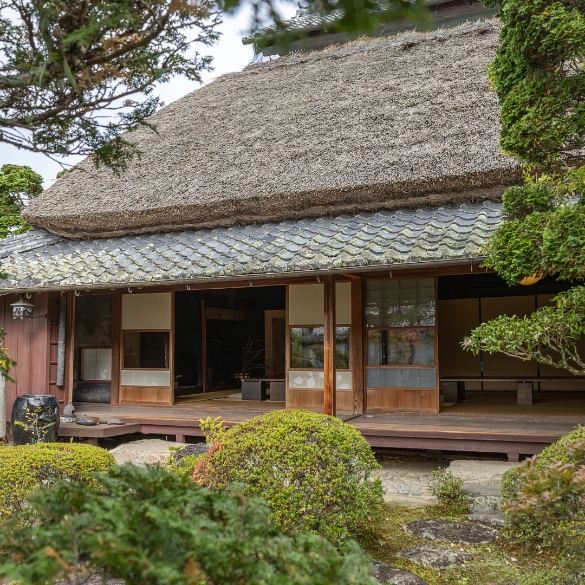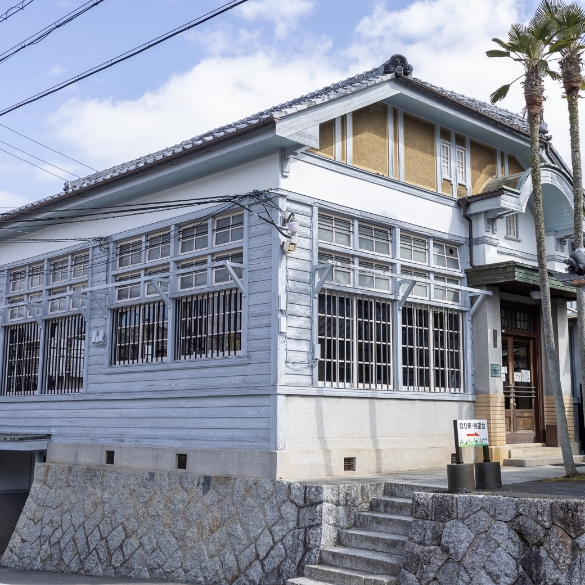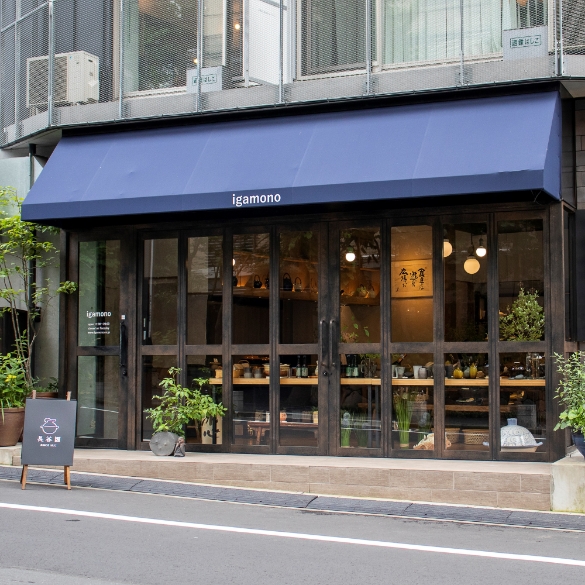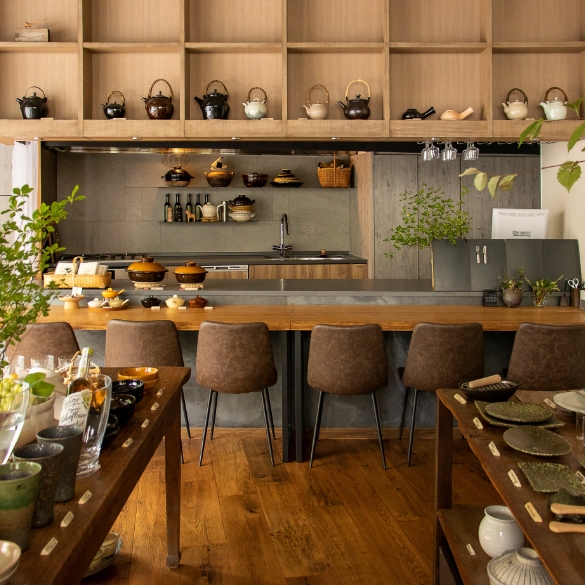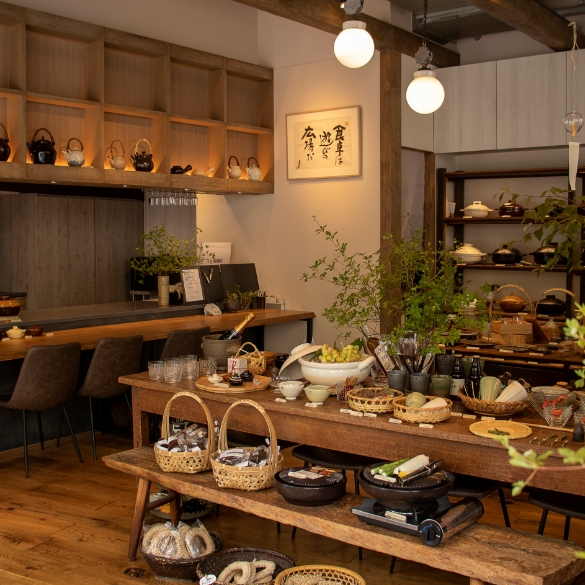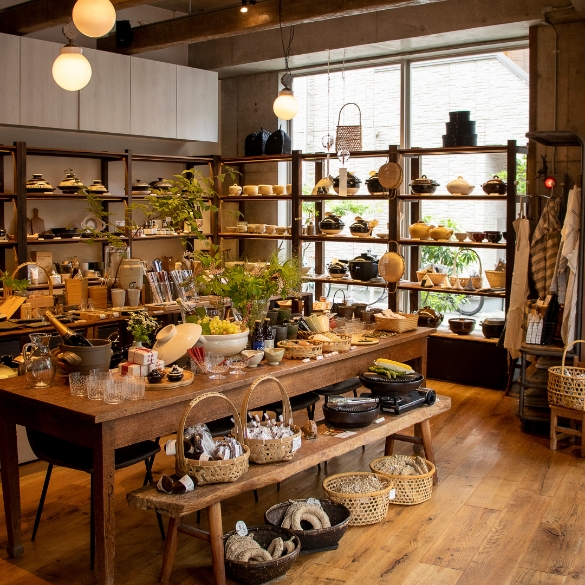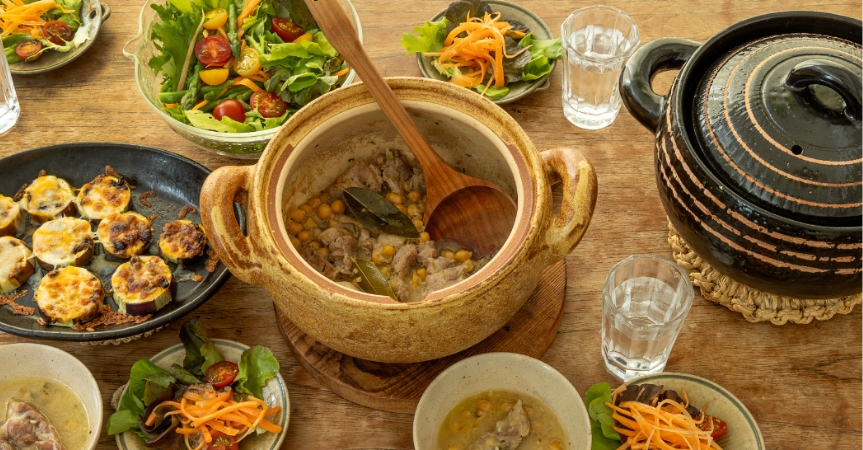Iga-yaki and Nagatani-en
What is “DONABE”?
“DONABE” is Japanese traditional earthen cookware setting over heat. “DO” means clay, and “NABE” means pot.
Iga-yaki (Iga-Style) Donabe – Top choice for many professional chefs
The clay from Iga region is said to be the most highly heat-resistant of those from any other regions, owing to which various kinds of open-fire cookware such as donabe, Yukihira cooking pots, and Dobin teapots have been produced in this region. Products made from the clay from Iga region are called Iga-yaki.
Iga clay has unique characteristics of being exceptionally porous, which gives the donabe remarkable heat-retention ability and allows it to produce gentle steady heat that penetrates to the core of ingredients and to seal all the flavors inside. The clay demonstrates the effect of far inflared radiation, due to which the Iga-yaki cookware has since long been fondly chosen by professional cooks for multi-purposes of cooking such as stewing, sautéing, steaming, roasting, etc.
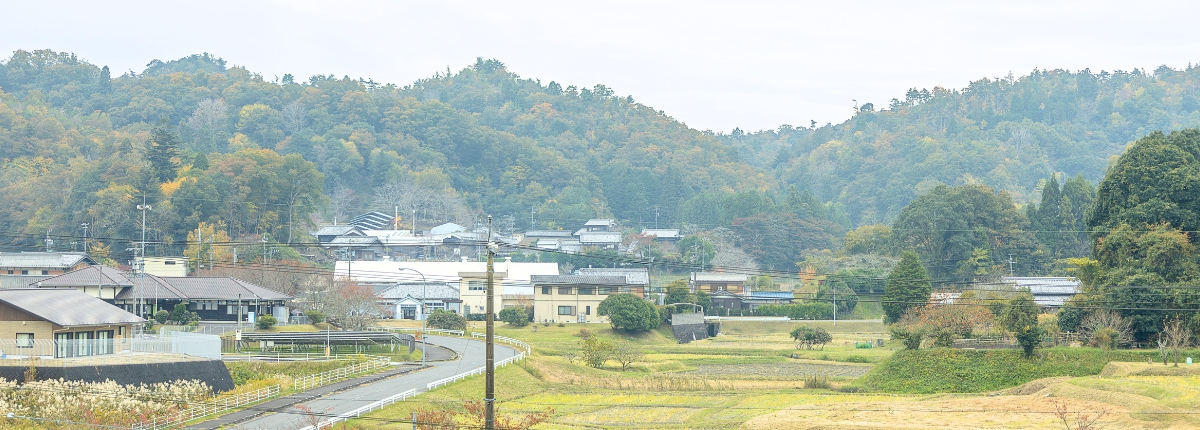
Iga-Yaki and Chanoyu (Japanese Tea Ceremony)
The region of Iga used to be part of the bed of Lake Biwa, and the clay from the geographical strata contains many fossilized microorganisms. Iga-yaki made from the clay, after the process of being fired at high temperature with the microorganisms completely burned, gets a number of tiny holes in its body and thus becomes porous.
The history of Iga-yaki dates back to about 1,200 years ago. “Ko-iga” (Antique Iga-style pottery)”, known as the masterpiece of all Iga-yaki pieces of work, is renowned for its use in tea ceremonies, that includes tea urn, water pitcher, tea caddy and flower vase. The beauty of Ko-Iga is said to be the foremost among all the tea utensils, and many pieces of work are exhibited in various museums in Japan.
-
 A typical Iga-yaki work “Mimitsuki-hanaire” (vase with ears), Tokyo, Tokyo National Museum
A typical Iga-yaki work “Mimitsuki-hanaire” (vase with ears), Tokyo, Tokyo National Museum
-
 A typical Koiga-yaki work “Yabure-bukuro” (burst pouch), Tokyo, The Gotoh Museum
A typical Koiga-yaki work “Yabure-bukuro” (burst pouch), Tokyo, The Gotoh Museum
Nagatani-en’s Iga-yaki that connects Chanoyu spirit and our daily life
The establishment of Nagatani-en dates back in 1832, the late Edo period, taking over the long-standing tradition and aesthetic feeling of Iga-yaki. From the fact that our start of business coincides with the time when Konabe-tate (serving a hot pot over a portable charcoal grill set at a dining table) became popular in the city of Edo (the former name of Tokyo), it is considered that we were engaged in making heat-resistant cookware such as donabe, Yukihira cooking pots, Horoku roasters, etc. right from the beginning.
Nagatani-en have evolved over the ages in close association with the local society and people. And the craftspersonship and aesthetic feeling developed through long experiences of making donabe and cook & tableware have been inherited over generations as intangible asset called tradition till today.
You can learn a lot more about donabe and Japanese culture in English on this informative website curated by TOIRO(Nagatani-en’s Official US Agent). Do visit the website and enjoy!
Tradition and Craftspersonship
There is an expression in Japanese “Nabe o kakomu” – getting together over one pot Donabe dish.
Delightly sharing a communal donabe meal brings people together and invites conversation and bonding. It is an important spirit of Japan.
Nagatani-en, preserving the tradition of Iga-yaki, aspire to produce cook & tableware that are integrated into everyday’s life.
Just as our motto “Table is a ‘playground’ for joyful culinary experiences,” we genuinely wish to help all our customers make meals more enjoyable and something special each and every time.
We are committed to carrying on the tradition of Iga-yaki and culinary cuture of donabe to the future.
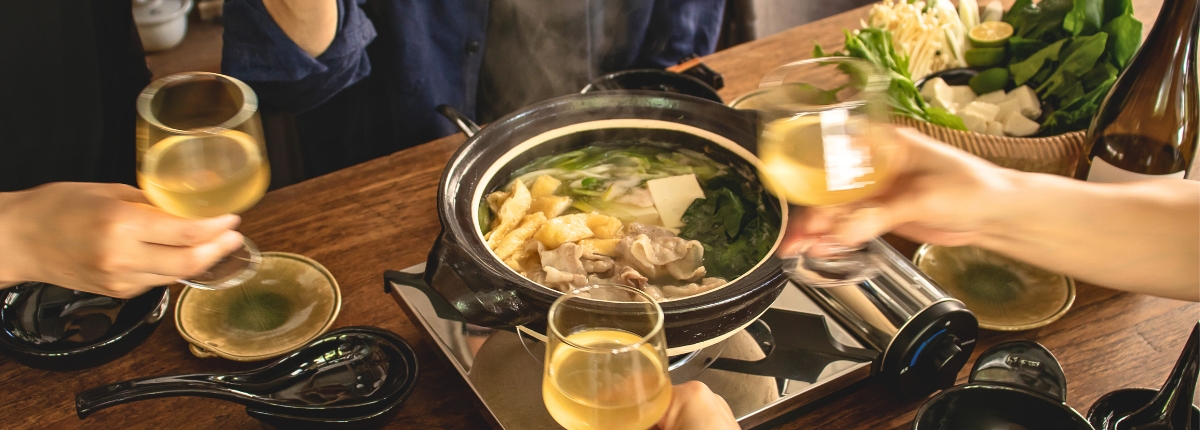
Our Bestsellers
Each piece of Nagatani-en’s donabe, carefully handcrafted by skilled artisans, has its speciality and is designed for a specific cooking method, such as rice cooking, steaming, smoking, etc.
As our company creed “Producers must be the ‘serious’ Donabe users. ” depicts, Nagatani-en’s donabe came to life purely in pursuit of the best possible eating and drinking. Experience the culinary delights of Nagatani-en’s donabe!
Donabe Rice Cooker “Kamado-san”
Traditionally, rice used to be cooked in donabe in Japan. Compared to metal pot, donabe slowly and gently builds the heat and cooks rice deliciously. Troublingly enough, however, conventional donabe requires constant watch on the heat level.
“Kamado-san” made a debut from our deepest passion for daily relishing donabe-cooked rice more easily. “Kamado-san” is so designed that does not require readjustment of heat.
Donabe Steamer “Mushi Nabe”
This Donabe Steamer “Mushi Nabe” is designed to cook the ingredients with the fast steam along with the effect of far infrared rays. As a result, the ingredients can cook fast while maintaining the natural flavors and nutrients of each ingredient inside. For fish or meat, its excess fat tends to drain through the steamer plate during cooking – it is a smart choice for health-conscious people! By removing the steamer plate, the Donabe Steamer can work as an all-purpose classic-style donabe to enjoy hot pot, braising, etc.
Donabe Smoker “Ibushi Gin”
This uniquely designed Donabe Smoker makes possible the easy stove-top home smoking.
By pouring water in the reservoir between the donabe body and lid, the lid becomes tightly sealed without releasing the smoke outside.
Donabe for Soup and Stew “Miso Shiru Nabe”
The round-shaped extra-thick body continues to cook for a while even after turning off the heat and stays hot for a long time.
It can also be used without any liquid inside, so you can sauté, stir-fry or roast ingredients in it, too.
Donabe Grill “Fukkura-san”
The Iga-yaki skillet and lid seal all the good flavors inside and cook the ingredients succulent and tender. “Fukkura-san” is also oven-safe.
Classic-style Donabe “Iga Donabe”
Nagatani-en’s donabe made from the porous clay of Iga region is designed to maintain the traditionally classic look, yet to ensure high usability in the modern life.
Our Shops
Iga Main Shop
Our Main Shop is located in Marubashira, Iga where Nagatani-en was founded, along with the over-200-year-old thatched-roof house (the former residence of Nagatani Family), factory, warehouses, and nice walking area.
Our property consists of 3 shops (Shop Gallery 1-3), museum, lookout as well as “16-level Connected Climbing Kiln” (the largest existing climbing kiln in Japan established in 1832) and “Taishokan” (a historic building previously used as office during Taisho era and now a guest room for visitors) – both registered as National Tangible Cultural Property. Enjoy strolling around in this rustic atmosphere richly endowed with nature and history of Iga-yaki (Iga-style) pottery.
[Address] 569, Marubashira, Iga, Mie 518-1325.
[Access] approx. 1.5 hours from Kyoto/Osaka, 1 hour from Nagoya/Nara by car
-
 Iga Main Shop
Iga Main Shop
-
 16-level Connected Climbing Kiln
16-level Connected Climbing Kiln
-
 Historic House of Nagatani Family
Historic House of Nagatani Family
-
 Construction dating from Taosho Period
Construction dating from Taosho Period
Tokyo Showroom/Shop
Our antenna shop in Ebisu, Tokyo offers not only donabe and tableware, but also delicacies from Iga region. You will surely find attractive tips and items to make your dining tabletop a fun place.
[Address] 4-11-8 (1F), Ebisu, Shibuya, Tokyo 150-0013.
[Access] 6-minute walk from Ebisu Station
Overseas Retailers
■Official US Agent
TOIRO
[Address] 1257 N La Brea Ave., West Hollywood, CA 90038
[Web site] https://toirokitchen.com/
■Asia
– China
DEARYOU Zakka & Toast 浦东嘉里城
[Address] 上海市 浦东新区 花木街道 浦东新区花木路1378号 浦东嘉里城商场一层L120号
帝爱优家家居旗舰店
[Web site] https://m.tb.cn/h.TWY6wBsJIgjC1eG
LINEPARK
[Address] Building 11, Dongxinhe Innovation Park, No. 139, Liuhe Road, Xihu District, Hangzhou, Zhejiang, China
[Web site] http://www.line-park.com/
– Taiwan
Housewoo
[Web site] https://www.housewoo.tw/
– Korea
KITCHEN-TOOL
[Address] 17−2 Hyeonchung-ro 6-gil, Nam-gu, Daegu, South Korea
[Web site] https://kitchen-tool.co.kr/
– Singapore
ATOMI
[Address] 333A Orchard Road , #04-27 Mandarin Gallery
Singapore 238897
[Web site] https://www.atomi-jp.com/
– Thailand
FRIEND FRIEND
[Address] 3rd Floor, Emporium, 622 Sukhumvit Road, Khlong Tan, Khlong Toei, Bangkok 10110, Thailand
[Web site] https://wearefriendfriend.com/
■Australia
CIBI
[Address] 33-39 Keele Street, Collingwood, MELBOURNE, AUSTRALIA 3066
[Web site] https://cibi.com.au/
Heirloom
[Address] 42 East Terrace, Loxton, South Australia
[Web site] https://www.heirloomqualitysupplies.com/
MINIMARU
[Address] 349 Clayton Rd, Clayton VIC 3168 Australia
[Web site] https://minimaru.com/
MINIMARU Chadstone
[Address] Chadstone – The Fashion Capital, Shop B181/1341 Dandenong Rd Floor L •, Malvern East VIC 3145 Australia
■Europe
Irasshai
[Address] 40 Rue du Louvre, 75001 Paris, France
[Web site] https://irasshai.co/
NIHON MONO GMBH.
[Address] Potsdamer Str.93 Berlin 10785 Germany
[Web site] https://www.nihon-mono.com/
Recipes
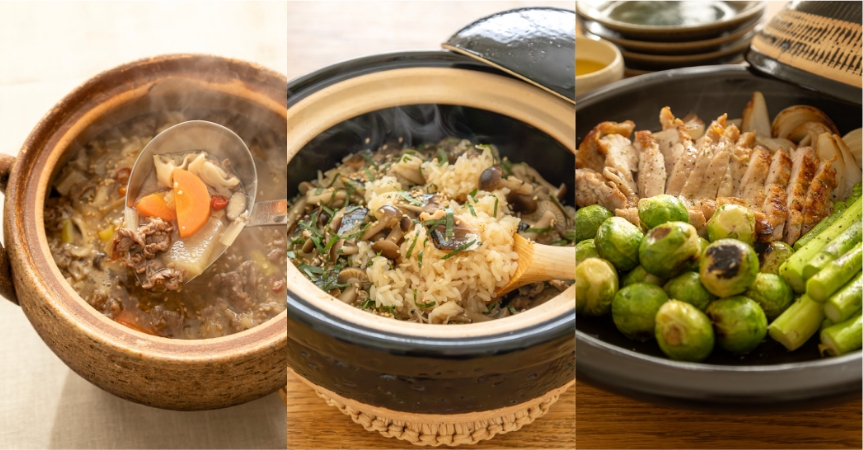
Click here for recipes for relishing seasonal flavors of Japan.(Japanese only)
Frequently Asked Questions
Following are some Most Frequestly Asked Questions such as how to use donabe, among others.
Q. Do you ship internationally?
We do not ship to addresses outside Japan, in principle.
Please get in touch with a retailer closest to your location.
For more details about our overseas retailers, click here >>>
Q. How to do ‘medome’ or cooking thick rice porridge in donabe?
Donabe requires seasoning (called ‘medome’) before first use. This simple step involves cooking Omoyu, or rice porridge in donabe. As the clay is highly porous and susceptible to leaking without proper care, the rice starch formed when cooking porridge will fill the pores of the clay and prevent the absorption of water. This process makes your donabe long-lasting.
Steps to cook thick rice porridge
(1) Rinse donabe thoroughly. Wipe off the water, place donabe upside down and air dry completely. *Donabe may crack if heated when it’s still wet.
(2) Put a bowl of leftover rice in donabe and pour water until 80 % full.
(3) Mix it together, bring to boil on low heat and cook the porridge till it gets thick.
(4) Turn off the heat and let it cool for more than 1 hour. Take out the porridge and rinse the pot with cold water (The porridge can be eaten after seasoning).
Q. How to wash donabe
Hand wash with lukewarm water. Use sponge and mild detergent to clean stuck food, but rinse off the detergent promptly, otherwise it may seep into donabe. To remove tough food stains inside, put lukewarm water into donabe and leave it for some time. After washing donabe, wipe it thoroughly, place it upside down and air dry it completely.
Q. What is the best place for storing donabe?
Store donabe at a well-ventilated place with low humidity. The space under the kitchen sink is highly humid, and there is a high chance of getting moldy.


